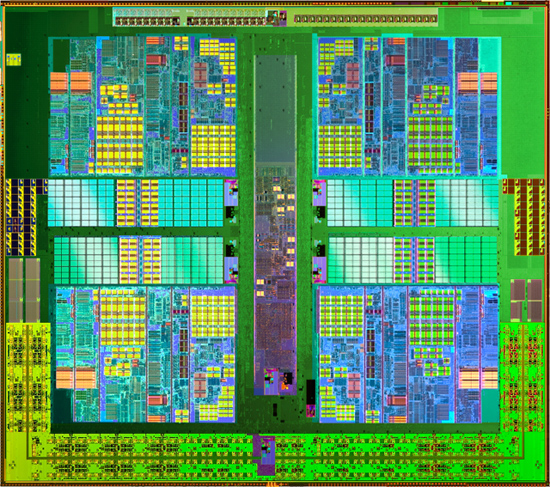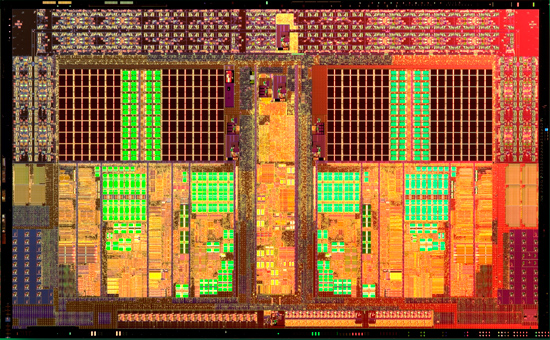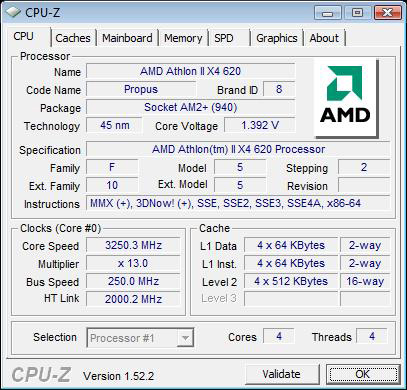AMD Athlon II X4 620 & 630: The First $99 Quad Core CPU
by Anand Lal Shimpi on September 16, 2009 12:00 AM EST- Posted in
- CPUs
How does AMD respond to Lynnfield? Is it by drastically cutting prices on Phenom II? Nope. By introducing the world’s first quad-core processor to debut at $99. Now that’s cool.

It’s called the Athlon II X4 and its existence shouldn’t be any surprise. AMD quietly announced it along with the Athlon II X2 line.

Today we get two models: the Athlon II X4 630 and the Athlon II X4 620, priced at $122 and $99 respectively. The only difference between the two is clock speed; the 630 runs at 2.8GHz while the 620 runs at 2.6GHz. These are both AM3 chips meaning they'll work in AM3 motherboards with DDR3 memory or AM2+ boards with DDR2 memory.
| Processor | Clock Speed | L2 Cache | L3 Cache | TDP | Price |
| AMD Phenom II X4 965 BE | 3.4GHz | 2MB | 6MB | 140W | $245 |
| AMD Phenom II X4 955 BE | 3.2GHz | 2MB | 6MB | 125W | $245 |
| AMD Phenom II X4 945 | 3.0GHz | 2MB | 6MB | 125W | $225 |
| AMD Phenom II X3 720 BE | 2.8GHz | 1.5MB | 6MB | 95W | $145 |
| AMD Phenom II X2 550 BE | 3.1GHz | 1MB | 6MB | 80W | $105 |
| AMD Athlon II X4 630 | 2.8GHz | 2MB | 0MB | 95W | $122 |
| AMD Athlon II X4 620 | 2.6GHz | 2MB | 0MB | 95W | $99 |
| AMD Athlon II X2 250 | 3.0GHz | 2MB | 0MB | 65W | $87 |

This isn’t a harvested Phenom II nor is it a pair of Athlon II X2s, instead it looks like we have a brand new die on our hands (some Athlon II X4s will be crippled Phenom IIs but AMD insists that the new die will be used). The Athlon II X4 has four cores on a single die, but unlike the Athlon II X2 each core only has a 512KB L2 per core. You can tell by the die shot that the core-to-cache ratio is much higher than on the X2:

The 45nm Athlon II X4 Propus die

The 45nm Athlon II X2 die (note the larger L2 per core)
Like the rest of the Athlon II lineup there is no L3 cache. This helps keep the die small (and affordable) but also hurts performance:
| Processor | SYSMark 2007 Overall | E-Learning | Video Creation | Productivity | 3D |
| AMD Phenom II X4 920 (2.8GHz) | 173 | 151 | 212 | 167 | 167 |
| AMD Athlon II X4 630 (2.8GHz) | 157 | 128 | 221 | 131 | 162 |
| % of Phenom II X4 | 91% | 85% | 104% | 78% | 97% |
At the same clock speed the Athlon II X4 should offer roughly 90% of the performance of a Phenom II X4.
| Processor | Cores | Manufacturing Process | L1 Cache | L2 Cache | L3 Cache | Die Size | Transistor Count |
| AMD Phenom II X4 | 4 | 45nm | 128KB per core | 512KB per core | 6MB | 258 mm2 | 758M |
| AMD Athlon II X4 | 4 | 45nm | 128KB per core | 512KB per core | 0MB | 169 mm2 | 300M |
| AMD Athlon II X2 | 2 | 45nm | 128KB per core | 1MB per core | 0MB | 117 mm2 | 234M |
| Intel Core 2 Quad Q8xxx | 4 | 45nm | 64KB per core | 4MB | 0MB | 164 mm2 | 456M |
The price is unbeatable. If we ignore the 630 for a moment, the Athlon II X4 620 is by far the cheapest route to four cores on the market. Intel’s most affordable quad-core is the Core 2 Quad Q8200 at $163, while AMD would previously charge you $163 for a Phenom X4 9600B. This is where the AM3/AM2+ compatibility play really helps out. Motherboard/memory costs are as cheap as possible thanks to AMD's incredible socket flexibility.

And just in case you’re wondering, yes, the Athlon II X4 620 actually delivers performance competitive with the Q8200 but for 60% of the cost. It’s not all that clear cut, there are some cases where the 620 is faster but others where the Q8200 is much faster. On average it ends up being a wash but you’ll want to pay attention to the coming pages to see how the cookie crumbles as it does vary from test to test.

Codename Propus
Overclocking isn't unfortunately as good as the Phenom IIs; the result of a conscious design decision or simply the early nature of the Propus die. That being said, without a single extra millivolt I was able to hit 3.25GHz on my Athlon II X4 620 sample - making it even more valuable. Extra voltage proved mostly useless, I could only approach 3.4GHz with an extra 300mV.
Let’s see, have I thoroughly ruined the surprise? Check. Now let’s get to the tests.
The Test
| Motherboard: | Intel DX58SO (Intel X58) Intel DX48BT2 (Intel X48) Gigabyte GA-MA790FX-UD5P (AMD 790FX) |
| Chipset: | Intel X48 Intel X58 AMD 790FX |
| Chipset Drivers: | Intel 9.1.1.1015 (Intel) AMD Catalyst 8.12 |
| Hard Disk: | Intel X25-M SSD (80GB) |
| Memory: | Qimonda DDR3-1066 4 x 1GB (7-7-7-20) Corsair DDR3-1333 4 x 1GB (7-7-7-20) Patriot Viper DDR3-1333 2 x 2GB (7-7-7-20) |
| Video Card: | eVGA GeForce GTX 280 |
| Video Drivers: | NVIDIA ForceWare 180.43 (Vista64) NVIDIA ForceWare 178.24 (Vista32) |
| Desktop Resolution: | 1920 x 1200 |
| OS: | Windows Vista Ultimate 32-bit (for SYSMark) Windows Vista Ultimate 64-bit |










150 Comments
View All Comments
The0ne - Wednesday, September 16, 2009 - link
Whether you like to believe it or not, crippling or, in a nicer way, not release some of the features is pretty common in both software and hardware environments. Whether the decision was due to money, managerial ignorance, or a time-line it is still a feature that is not in the product that could be there.If you consider putting all features, which is impossible btw, then you run into issues where the consumer or market doesn't even need them. We have USBs, wireless, biometric security available in one of our product but 95% of the market could care less. They are still on serial lines and are uneducated on newer technologies. Most city halls are like this that is why you see plain old switching voting systems still in place and the occasional typewriter.
The0ne - Wednesday, September 16, 2009 - link
You mean like the I5?andrenb91 - Wednesday, September 16, 2009 - link
it's just a cpu...I'll buy it when I need it, my amd athlon 4850e and intel pentium dual-core e5200 still good enoughMrCommunistGen - Wednesday, September 16, 2009 - link
Anyone know where you can get these? If not yet available, then when? I have a friend who needs a new computer, and the AII X4 620 would be a pretty good fit for him. I was somewhat grudgingly recommending the Ph II X2 550, but the X4 620 seems to offer much more balanced performance.pervisanathema - Wednesday, September 16, 2009 - link
These results are meaningless. The intel CPUs should be forced to run 24x7 at their highest possible turbo speed. To do otherwise let's AMD lose by a smaller margin.i'm going to stay here saying the same until hell freezes.
i'm not going to accept under clocked results presented as if they were stock results.
this is a casus belli.
i mean it.
fitten - Wednesday, September 16, 2009 - link
Heh... I see what you did there ;) I'm with you!johnsonx - Wednesday, September 16, 2009 - link
lolClownPuncher - Wednesday, September 16, 2009 - link
I see what you did there! Nice jobExar3342 - Wednesday, September 16, 2009 - link
For $50 more, you get a much more energy efficient and faster processor. I would only recommend this quad to those with a MB that supports it, they need an upgrade, and they don't have much cash.AMD can't be making much money off these processors...
bji - Wednesday, September 16, 2009 - link
"For $50 more" means "for 50% more" in this case. It's kind of ridiculous to talk about the difference of $50 in this context as if it's trivial. Those costs are not remotely comparable, so the implication that you might as well just spend $50 more to get the faster/more efficient processor is not justified by your statements.I personally always do target $150 for a processor price when building a new system - this is a habit I got into with my very first build, using a Pentium 100 which at the time cost $150. This means that a $200 processor which has better performance is not even in the realm of consideration for me, even though it is "only $50 more", which in this case, is an even smaller percentage increase than in the case you are talking about.
Just in case I haven't made my point abundantly clear: you can't recommend spending $50 more for someone who has budgeted $100 for the processor. You have to compare similarly priced CPUs. I would like to see more comparisons with the Phenom II 550 BE for that reason.